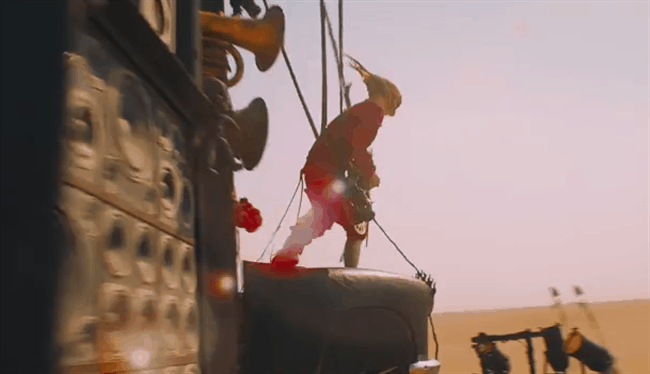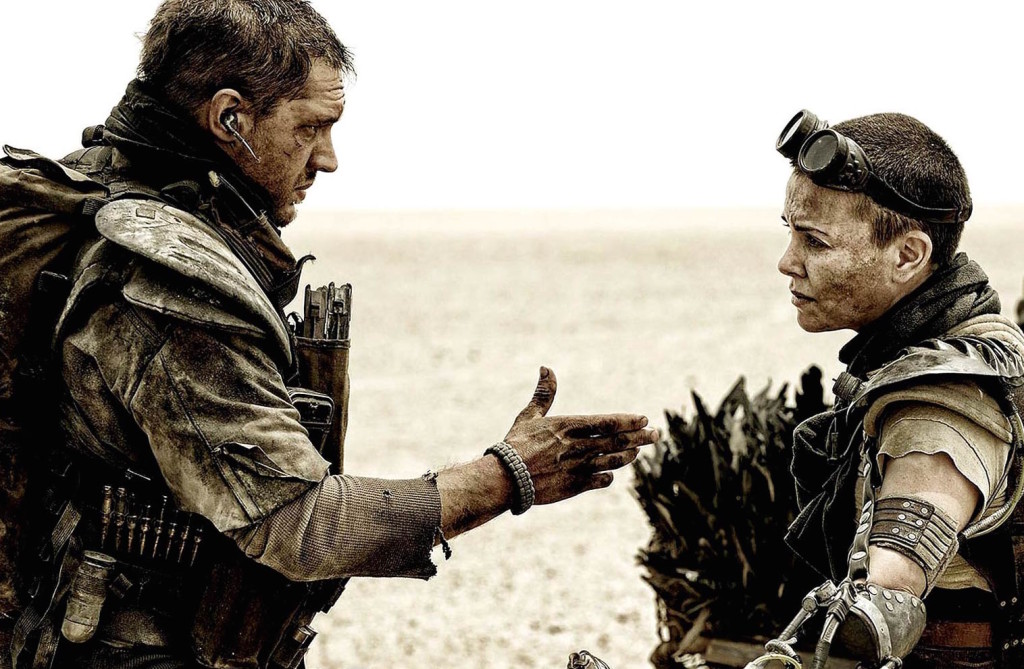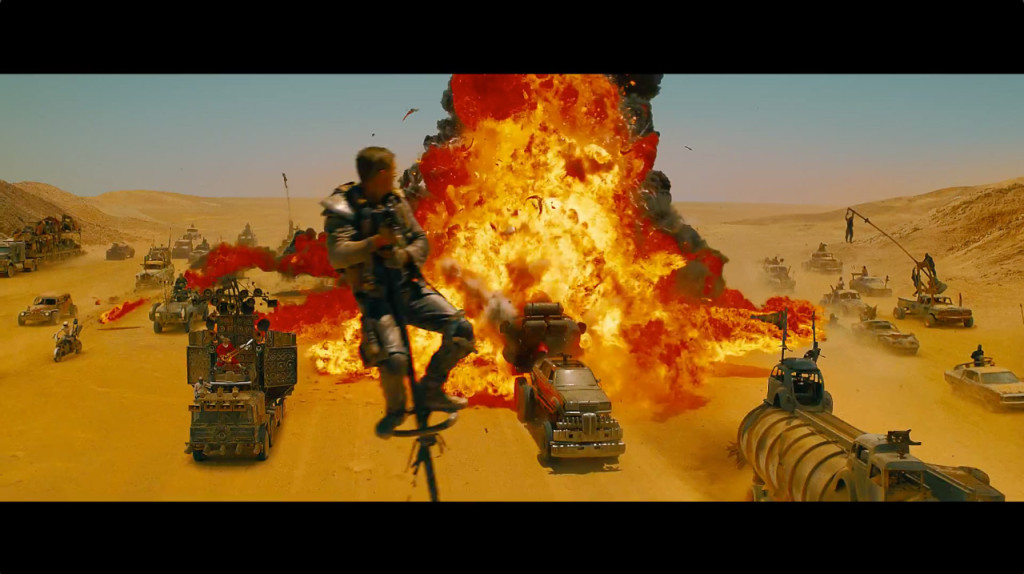We here at The Addison Recorder read stuff. We also watch stuff. And play stuff, even are sort of wild about Mad Max: Fury Road. Sometimes, that stuff is interesting. Sometimes we just need to talk about whatever pop culture ephemera occupies our time Mad Max: Fury Road. Here’s some of the staff of the Recorder talking about their favorite parts of what’s shaping up to be one of the best action movies of the decade. Chrome on. Our Month in Pop Culture Mad Max: Fury Road
Travis
Holy shit, guys.
I don’t even know where to begin, how to begin, or what to talk about. The movie’s staunchly feminist agenda. The visuals. The perfect use of minimalist narrative to create compelling characters. The fact that I couldn’t unclench my fists for the first forty minutes of the film. Jesus God, this movie was an experience, one that defies words for me.
Instead, let’s talk about this guy:
 His name is the Coma-Doof Warrior. He’s kind of the drummer boy/bugle corp of the army of War Boys that chases after Max, Furiosa, and the runaway sex slaves on their quest for the Green Place. He rides aboard the Doof Wagon, four pasty warriors pounding away on bass drums behind him as he “riles up the troops”. There’s even a full backstory where Immorten Joe finds and recruits Coma-Doof Warrior when he finds him sitting alone cradling his mother’s head in the desert.
His name is the Coma-Doof Warrior. He’s kind of the drummer boy/bugle corp of the army of War Boys that chases after Max, Furiosa, and the runaway sex slaves on their quest for the Green Place. He rides aboard the Doof Wagon, four pasty warriors pounding away on bass drums behind him as he “riles up the troops”. There’s even a full backstory where Immorten Joe finds and recruits Coma-Doof Warrior when he finds him sitting alone cradling his mother’s head in the desert.
This is a single character with about three minutes of screen time in a movie full of wildly original characters. That this level of detail has been put into what might have been a throwaway character in any other action movie should tell you what kind of movie Fury Road is.
Also, holy shit, this guy exists. I want this job.
hiring an intern your only responsibility is hang from the front of my car and play guitar like on Mad Max lemme know if you're interested
— Shea Serrano (@SheaSerrano) May 19, 2015
Andrew
Mad Max: Fury Road is a feat of pure audio-visual kinetic cinema excellence, with three of the most senses-obliterating moments I’ve ever seen in film.* But these sequences would not carry the same resonance if not for the work George Miller and company do to build the relationship between Max Rockatansky and Imperator Furiosa—a relationship all writers would do well to take as a model for character building.
When the film begins, Max, for all his capabilities, is an aimless drifter, haunted by the memories of everyone he couldn’t save. He lives without hope or any thoughts of a good future. Then he meets Furiosa, who has lived through as much as he has, but who stands for something far different from the exploitative domination of Immortan Joe. She still carries hope, and the dream of an egalitarian, peaceful future, with her. It’s a hope strong enough to inspire the wives, and this hope reignites the best qualities of Max, so that when Furiosa has her moment of weakness, Max is there to give her the strength to finish her quest. Moreover, before, during, and after their arc, Max and Furiosa complement each other in terms of action. Whenever one falters in any way, the other steps up to complete the job, be it car repairs or taking down an armada of nemeses. (The scene where Furiosa uses Max as a rifle perch is the ne plus ultra.)
Neither Max nor Furiosa need a lover, let alone someone to kiss when it’s all over. They need someone who can stand beside them in a fight worth fighting, and when they recognize the person they need in each other, they form a solidarity more powerful than many love stories. Of the many ways Fury Road shatters the action movie mold, this central relationship where neither part feels like a mere device is one of the best.
*The three scenes, by the way, are the sandstorm, Furisoa’s arrival in the Green Place, and the final chase. I’m getting chills just thinking about them again.
Alex:
Let’s keep this brief. Mad Max: Fury Road is an movie of insane genius. It’s the best action movie I’ve seen since Gravity and more fun than that film by half. There are two things that I’ll point to as helping it become so fucking good.
First, it creates a fleshed-out world through action and images instead of exposition. I came into Fury Road not having seen any of the other Mad Max movies. I was familiar with their premise, but had few details beyond that. Thankfully, George Miller didn’t give a shit if I had seen his other movies. He spend a moment or two having Tom Hardy half-grunt some narration that essentially says “World ended. Here we are.” Then the shit hits the fan and the narrative goes forward full throttle. Contrast that with what Andrew saying last month that Age of Ultron needed an extra 30 minutes to flow better. And that’s from a guy who liked the movie! Miller cuts through the crap and gives us images like the starving masses and actions like Max’s desperate escape attempt that tell us the place and the stakes in a few seconds instead of a few scenes. Even the small details of the art direction and costume design give us character and narrative details that the movie doesn’t have to waste further time on. It’s a lean and mean movie all the way through.
Second, Miller makes amazing use of practical effects, real-life scale, and impactful editing in this movie. The rise of CGI in the past 15 years has uncouple the movie camera from its practical bounds. That can be amazing in the right hands (see: Cuarón, Alfonso), but can also lead to visual clutter, sloppy cuts, and hand-holding. I like most of his movies, but look at someone like Christopher Nolan who is seemingly trusts effects too much (no, that tower fight in The Dark Knight still makes no spatial sense) and his audience too little (“If that train gets here it’ll blow the whole system…If that train gets here it’ll blow the whole system!”). Miller takes Nolan and his ilk to school with Fury Road. Look at the real stuntpeople doing really crazy shit (those wavering poles!), the way geography is established and then used dramatically (that crazy fucking sandstorm that overwhelms the rigs), and how Miller uses on-time and motivated editing to thrill the audience (when the pregnant wife, The Splendid Angharad, throws the door open to block Immortan Joe’s shot at Furiosa).Okay, fine, a quick third thing. I fucking loved that this movie pulled no punches without ever glorifying its violence. That’s a really fine line to toe and even very good filmmakers wind up on the wrong side of it. Here, Miller makes it clear that the whole damn world is crazy, doomed, and repellent. While this adventure is a badass spectacular, it uses violence and action as a means to a narrative end and never as a self-justifying gory spectacle. Which makes the emotions punch harder and the narrative conclusion more meaningful.
-J.
It’s called Mad Max: Fury Road, but the movie isn’t about Max. These movies haven’t really been about Max since the first one. The poor sumbitch is like a burnt-out Rod Serling whose coherent thoughts are little more than surviving this insane wasteland. Despite his best attempts to avoid humanity, Max keeps running into people in the vast hellscape where time has no meaning. More importantly for us, he keeps stumbling into other people’s stories.
This is not Max’s story. He is merely a vessel for the narrative. This is Furiosa’s story. This is the story of Capable, of Nux, of the cultures from which they were borne and shaped. When the narrative has run its course, there is no longer a purpose for Max. He has survived. He has witnessed. He moves on. This is true from a character and a storytelling frame of reference, and this decision from creator George Miller is what keeps these stories compelling.
As this piece runs its course, we start were we began: with the thrumming chords and drumbeat that drives Mad Max: Fury Road. It is an illuminating example of how sound and music can amplify and enhance a film. We have spent an entire film getting jacked up by every sound accompanying the visuals Andrew and Alex lauded. We are left with an intense feeling that defies description, as Travis posits. The only seemingly rational reaction is to exit to the lobby and unleash a primal scream.







